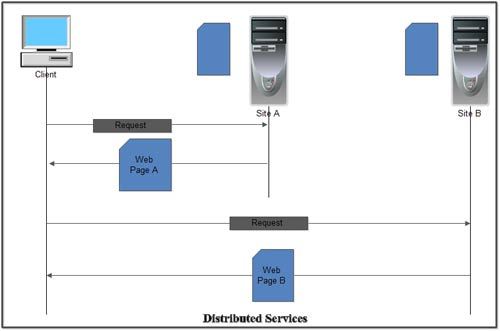The WWW is the brainchild of Tim Berners Lee a CERN who had the idea of creating an electronic web of research information. The web is currently the fastest growing Internet information system, with new resources being added regularly. The web relies on a set of protocols, conventions and software to operate. The web is a distributed system of delivering linked documents over the Internet.
It is called a distributed system because information can reside on different computers around the world. Yet be easily linked together using hypertext. The web uses hypertext to create links from together using hypertext. The web uses hyperte3xt to create links from one resource to another. A hypertext link is usually displayed by highlighted and underlined text on the page. A hypertext link or hyperlink can also be graphic that acts as a button linking to another resource.
• World Wide Web IS an architectural framework for accessing linked documents called web pages that are spread over thousand of computers all over the world.
• WWW is a set of programs, standards and protocols that allow the text, images, animations, sounds and videos to be stored, accessed and linked together in form of web sites.
• The WWW project was developed at CERN, the European Center for Nuclear Research in 1989.
• It has a unique combination of flexibility, portability, and user-friendly features that distinguishes it from the other services provided by the Internet.
Architecture of WWW
• WWW is basically a distributed client-server service. It this, a client can access the services from a server using a browser.
• These services are usually distributed over many locations called sites or websites.
• From the user’s point of view web consists of a vast worldwide collection of documents called web pages. These web pages reside on different sites or machines all over the world.
• Each web page can contain link to other pages any where in the world. By clicking on such link user can access another web page.
• This kind of link can be in form of string of text or picture, sound, movie clip etc.
• Such a text or image that enables the user to link to another web page is called hyperlink.

• The string of text that points to another web page is called hypertext. The difference between the normal text and hypertext is that, when you take the mouse pointer over it, it changes into a hand shaped cursor. Such a text is sometime, underlined and blue is colour.
• Hypermedia is enhanced form of a hyperlink which not only links to the other pages or other sections within the same page but can also link with various medium like sound, animation, movie clip etc, Hypermedia is grouping of different media like sound, graphics, animations and text in a single file.
• These hyperlinks are created with the help of specialized language called Hypertext Mark up Language (HTML).
• In order to access these web pages on different sites, each of these pages has a specific address called Uniform Resource Locator (URL).
• Web pages are viewed with a program called a browser.
 Dinesh Thakur holds an B.C.A, MCDBA, MCSD certifications. Dinesh authors the hugely popular
Dinesh Thakur holds an B.C.A, MCDBA, MCSD certifications. Dinesh authors the hugely popular